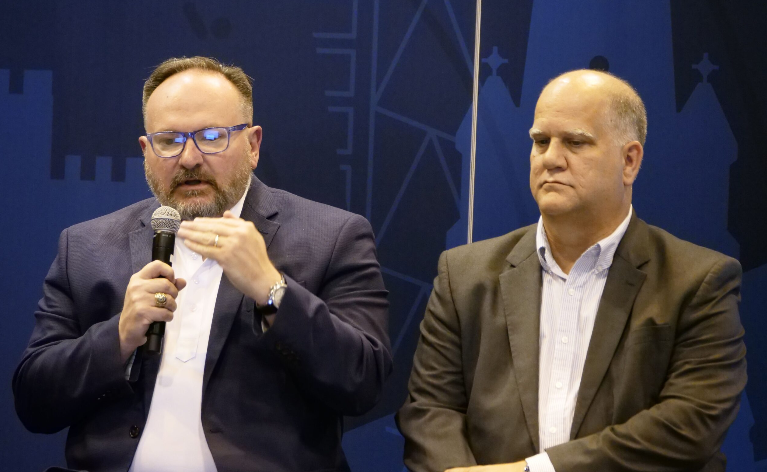Latest News
Despite Advances in AI Technology, it’s Still Not ‘Good Enough,’ NGA Official Says

Mark Munsell, left, director of NGA’s Data and Digital Innovation Directorate, speaking at the GEOINT 2023 Symposium. Photo: U.S. Geospatial Intelligence Foundation
ST. LOUIS — There is no need to pause development of artificial intelligence (AI) despite recent advances that have alarmed experts and policy-makers about hidden dangers in the use of the technology because it currently is “not good enough” and continued maturing of the technology will ultimately improve capabilities, an official with the National Geospatial-Intelligence Agency (NGA) said last week.
NGA’s primary investment focus is in “machine learning in the domain of computer vision … to be able to detect objects of interest, to be able to derive information from those objects, [and] to be able to do it with better initial accuracy,” Mark Munsell, director of the Data and Digital Innovation Directorate at the agency, said at the GEOINT 2023 Symposium.
NGA and the Defense Department are “not pausing” the development of this technology and “I say this because we’re still not good enough,” Munsell said. The intelligence officials that brief the combatant commanders and the president “are going to say we’re not good enough. They’re going to say that the positive identification of the objects is not good enough.”
The combatant commanders will say that the speed and accuracy of the AI technology is not where it needs need to be and that “we need better labels, we need better algorithms, [and] we need better models from those resulting in better detections, resulting in more useful information to be able to support the policy maker and our combatant commanders,” he said.
AI technology is becoming increasingly important to NGA because the amount of data the agency is collecting from remote Earth imaging sensors such as satellites is outpacing the ability of human analysts to scour for potential targets. Earlier this year NGA took ownership of the Defense Department’s Maven project, an AI and machine learning platform that the agency has integrated into its workflow to help customers such as the combatant commands automatically search and detect items of interest.
Vice Adm. Frank Whitworth, NGA director, told attendees here last week that the use of Maven has “increased fidelity of targets, improved geolocation accuracy, and refined our test and evaluation process.”
Munsell’s directorate oversees the Maven effort, which is expected to become a program of record later this year. NGA used the symposium as a platform to discuss Maven and Munsell said going forward “We’re going to do a lot more talking about Maven” and what the agency’s needs for the program are.
The actual object detection performance of Maven is classified, Munsell said, but he outlined the expectations.
“I have analysts of course that would expect things to be 100 percent accurate.” he said. “I have combatant commanders that will expect the object identification to be 100 percent and the geolocation accuracy to be two meters or less so they can deliver precision guided munitions. Those are the expectations. Are we there? We’re not there. Will we get there? Absolutely. It’s inevitable.”
While still not good enough, in the past four to five years AI technology has really taken off, Munsell said. The environment for further advances is ripe given the datasets and the fact that there is more computing power than ever before, he added.
In conjunction with GEOINT 2023, NGA issued its AI vision statement, which outlines three challenges that must be overcome before achieving its “primary goal of producing GEOINT data and AI models of increasing accuracy that generate high-quality and useful detections to be applied to defense and intelligence missions.”
The first challenge area is developing and adopting AI solutions, which it would appear NGA is tackling head on with the use of Maven. The second challenge area is around governance and prioritizes “investments in labeling, algorithm development, inference compute, and label and data management.” NGA’s customers need to know that the AI applied to their missions is “assured and secure” so they can trust it, the agency says of the third challenge area.
This article was first published by Via Satellite sister publication Defense Daily
Get the latest Via Satellite news!
Subscribe Now